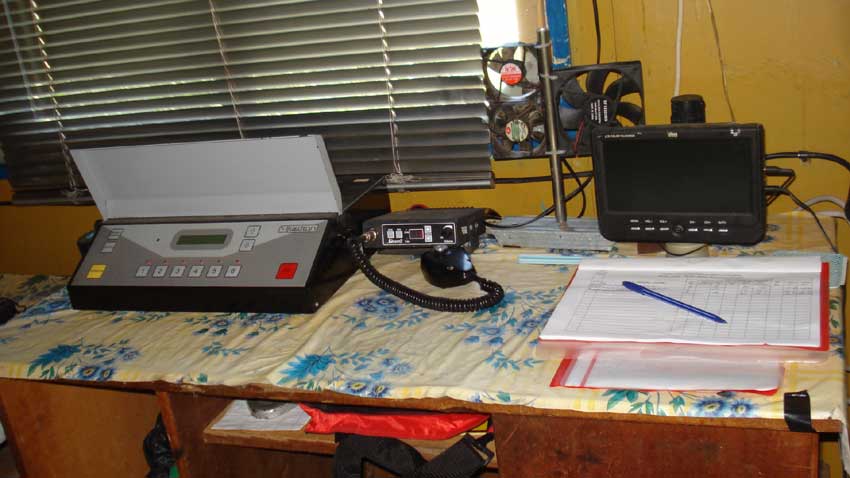Dark clouds fill the sky, followed by the first thunders. Storm is coming! Suddenly a loud peal tears the sky, and again, and again. Later, the earth is covered with fine spring rain.
The firing of anti-hail rockets can be seen in almost all parts of Bulgaria. This is so, because there are over 200 anti-hail facilities on the territory of this country, which fire rockets when hail clouds threaten to destroy the crops. The anti-hail system in Bulgaria was developed for the first time back in 1968 by the Ministry of Agriculture and Food and the first anti-hail firing ground was built later in the town of Saedinenie. It was a trial range, which was launched by the Bulgarian Academy of Sciences. Its purpose was to find out how anti-hail rockets influence the atmospheric processes, determine the effect of this activity and set the working methods of the teams, head of the regional anti-hail department in Vratsa district Yordan Yordanov told Radio Bulgaria. There are 24 anti-hail firing grounds in this district alone. Each of them protects a territory of 10 kilometers and the places where these systems were situated were selected after detailed analyses. We are talking about an integral system which allows at least two anti-hail grounds to fire rockets against a given hail cloud.
 “Our main task is to protect the agricultural produce from hailstorm. The anti-hail grounds in Vratsa district protect a territory of 170,000 hectares”, Mr. Yordanov went on to say. “When we fire rockets against a hail cloud the crops suffer 20%-30% damage, or in the best case scenario they are fully protected. However, it all depends on the weather conditions and the cold atmospheric fronts which enter the Bulgarian territory. The clouds rise to 10 kilometers up in the atmosphere during the hot days. The temperatures in the chilled layers are extremely low, which favors the formation of hail clouds. Then we start to fire anti-hail rockets against the cloud.”
“Our main task is to protect the agricultural produce from hailstorm. The anti-hail grounds in Vratsa district protect a territory of 170,000 hectares”, Mr. Yordanov went on to say. “When we fire rockets against a hail cloud the crops suffer 20%-30% damage, or in the best case scenario they are fully protected. However, it all depends on the weather conditions and the cold atmospheric fronts which enter the Bulgarian territory. The clouds rise to 10 kilometers up in the atmosphere during the hot days. The temperatures in the chilled layers are extremely low, which favors the formation of hail clouds. Then we start to fire anti-hail rockets against the cloud.”
There is a widespread belief that anti-hail rockets actually break the hail into pieces. However, the truth is that anti-hail rockets can not break the ice in the cloud. Once the hail fragments form inside the cloud the hailstorm can not be avoided. The anti-hail system works on a completely different principle called competition.

“When an anti-hail rocket is fired, it reaches an altitude of 3 kilometers, where it starts to disperse smoke containing silver iodide. The crystal lattice of this chemical substance is similar to the crystal lattice of the ice. When a water drop sticks to the crystal lattice of the silver iodide it freezes immediately. Later other water drops stick to the ice particle and form a hail grain, i.e. we bring artificial ice into the ice grain and prevent the formation of large hailstones. ”
For instance, the silver iodide helps the formation of 100 million small hail grains with the size of a wheat grain in a given hail cloud, instead of 1 million large hailstones with the size of a walnut. Most of the small hail grains melt on their way to the ground and those which reach the earth surface do not have the power and the size to destroy the agricultural produce. They may puncture some leafs, but the damage over the plants is insignificant, which is in fact the purpose of the anti-hail rockets.

Another wide-spread delusion is linked with the belief that hailstorm can form in the early afternoon hours, or early in the evenings only. However, this is not true. Hailstorm may occur early in the morning, or even during the nights. It all depends on the weather conditions. Unfortunately, the hailstorm can not be predicted in advance. The whole process lasts between 7 to 10 minutes only-from the time the hail cloud is formed to the moment hail hits the ground. That is why experts are forced to work in extremely short terms. Special Doppler devices send information about the processes happening within the clouds every 3 minutes. An intelligent system situated at the control center determines the coordinates of the hail cloud and sends the information to the given firing ground, where well-trained employees fire anti-hail rockets into the cloud. They have under a minute to fulfill the instructions.
English version: Kostadin Atanasov
Photos: Desislava IvanovaElena Ganeva-Robles has been living in London for more than 30 years . She was led there by the love of a Peruvian man she met at university in Bulgaria's coastal city Varna. After the fall of the Iron Curtain, the two set their sights on Great Britain,..
Over the past two weeks, fires in Bulgaria have scorched tens of thousands of hectares of trees, damaged dozens of homes in the Strandzha region and charred entire herds. The massive fires in Sakar and Svilengrad alone have destroyed almost 10,000..
The village of Gomotartsi in the region of Vidin has a strange history. It was once located in another place, miles away from where it is now. After a terrible plague struck a large part of its inhabitants, the survivors decided to burn their houses and..

+359 2 9336 661
